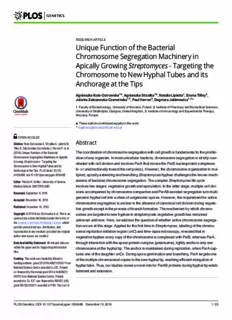
Kois-Ostrowska-etal-PLOSG2016-Bacterial-chromosome-segregation-machinery-in-apically PDF
Preview Kois-Ostrowska-etal-PLOSG2016-Bacterial-chromosome-segregation-machinery-in-apically
RESEARCHARTICLE Unique Function of the Bacterial Chromosome Segregation Machinery in Apically Growing Streptomyces - Targeting the Chromosome to New Hyphal Tubes and its Anchorage at the Tips AgnieszkaKois-Ostrowska1☯,AgnieszkaStrzałka1☯,NataliaLipietta1,EmmaTilley2, JolantaZakrzewska-Czerwińska1,3,PaulHerron2,DagmaraJakimowicz1,3* a11111 1 FacultyofBiotechnology,UniversityofWroclaw,Poland,2 InstituteofPharmacyandBiomedicalSciences, UniversityofStrathclyde,Glasgow,UnitedKingdom,3 InstituteofImmunologyandExperimentalTherapy, Wroclaw,Poland ☯Theseauthorscontributedequallytothiswork. *[email protected] OPENACCESS Abstract Citation:Kois-OstrowskaA,StrzałkaA,LipiettaN, TilleyE,Zakrzewska-CzerwińskaJ,HerronP,etal. (2016)UniqueFunctionoftheBacterial Thecoordinationofchromosomesegregationwithcellgrowthisfundamentaltotheprolifer- ChromosomeSegregationMachineryinApically ationofanyorganism.Inmostunicellularbacteria,chromosomesegregationisstrictlycoor- GrowingStreptomyces-Targetingthe dinatedwithcelldivisionandinvolvesParAthatmovestheParBnucleoproteincomplexes ChromosometoNewHyphalTubesandits bi-orunidirectionallytowardthecellpole(s).However,thechromosomeorganizationinmul- AnchorageattheTips.PLoSGenet12(12): e1006488.doi:10.1371/journal.pgen.1006488 tiploid,apicallyextendingandbranchingStreptomyceshyphaechallengestheknownmech- anismsofbacterialchromosomesegregation.ThecomplexStreptomyceslifecycle Editor:PatrickH.Viollier,UniversityofGeneva MedicalSchool,SWITZERLAND involvestwostages:vegetativegrowthandsporulation.Inthelatterstage,multiplecelldivi- sionsaccompaniedbychromosomecompactionandParABassistedsegregationturnmulti- Received:September8,2016 genomichyphalcellintoachainofunigenomicspores.However,therequirementforactive Accepted:November16,2016 chromosomesegregationisunclearintheabsenceofcanonicalcelldivisionduringvegeta- Published:December15,2016 tivegrowthexceptintheprocessofbranchformation.Themechanismbywhichchromo- Copyright:©2016Kois-Ostrowskaetal.Thisisan somesaretargetedtonewhyphaeinstreptomycetevegetativegrowthhasremained openaccessarticledistributedunderthetermsof unknownuntilnow.Here,weaddressthequestionofwhetheractivechromosomesegrega- theCreativeCommonsAttributionLicense,which tionoccursatthisstage.AppliedforthefirsttimeinStreptomyces,labellingofthechromo- permitsunrestricteduse,distribution,and reproductioninanymedium,providedtheoriginal somalreplicationinitiationregion(oriC)andtime-lapsemicroscopy,revealedthatin authorandsourcearecredited. vegetativehyphaeeverycopyofthechromosomeiscomplexedwithParB,whereasParA, DataAvailabilityStatement:Allrelevantdataare throughinteractionwiththeapicalproteincomplex(polarisome),tightlyanchorsonlyone withinthepaperanditsSupportingInformation chromosomeatthehyphaltip.Theanchorismaintainedduringreplication,whenParAcap- files. turesoneofthedaughteroriCs.Duringsporegerminationandbranching,ParAtargetsone Funding:ThisworkwasfundedbyMaestro ofthemultiplechromosomalcopiestothenewhyphaltip,enablingefficientelongationof fundingscheme,grant2012/04/A/NZ1/00057from hyphaltube.Thus,ourstudiesrevealanovelroleforParABproteinsduringhyphaltipestab- NationalScienceCentreawardedtoJZC,Poland, co-financedbyHarmoniagrant2014/14/M/NZ1/ lishmentandextension. 00076fromNationalScienceCentre,Poland awardedtoDJ.EJTwasfinancedbyBBSRC(UK) grantBB/D521657/1awardedtoPRH.Thecostof PLOSGenetics|DOI:10.1371/journal.pgen.1006488 December15,2016 1/25 ChromosomeSegregationduringHyphalGrowth publicationwasfinancedbytheWroclawCentreof Biotechnology,programmeoftheLeadingNational AuthorSummary ResearchCentre(KNOW)foryears2014–2018. Toproliferate,cellssynchronizegrowthanddivisionwithchromosomesegregation.In Thefundershadnoroleinstudydesign,data collectionandanalysis,decisiontopublish,or unicellularbacteria,chromosomessegregateduringreplicationbyactivemovementof preparationofthemanuscript. nucleoproteincomplexestowardthecellpole(s).Here,weaskedthequestionhowactive chromosomesegregationoccursintheabsenceofcelldivision,duringhyphalgrowthand CompetingInterests:Theauthorshavedeclared thatnocompetinginterestsexist. branchingofthefilamentousbacterium,Streptomycescoelicolor.Weshowthatinmultige- nomicStreptomyceshyphae,thebacterialsegregationmachineryanchorsasinglechromo- someatthehyphaltip.Throughchromosomalanchorage,segregationproteinsfacilitate chromosometargetingtothenewlyformedgermtubesorbranches.Thus,beingadapted forapicalgrowth,inStreptomyceshyphaethebacterialsegregationmachineryimposesa chromosomedistributionthatisreminiscentofnucleardistributioninapicallygrowing eukaryoticcellssuchasfilamentousfungi. Introduction Chromosomesegregationinunicellularbacteriaisstrictlycoordinatedwiththecellcycleand chromosomesaresegregatedduringtheirreplicationandpriortocelldivision.However,the spatialchromosomeorganizationinbacteria,determinedbythepositionoftheoriginofrepli- cation(oriC)inthecell,differswithrespecttothemorphologyandgrowthstrategyofthe organism[1–3].Thesedifferencesinchromosomeorganizationarereflectedinthespecific, cellcycle-tunedmechanismofchromosomesegregation[4,5].Inmostbacterialspecies(with theexceptionofEscherichiacoliandsomeγ-proteobacteria)efficientchromosomesegregation reliesontheactivityoftwoproteins,ParAandParB[4,6].BybindingparSsitesclustered aroundoriC,ParBassemblesthisregionofthechromosomeintoalargenucleoproteincom- plex.Soonaftertheinitiationofreplication,ParBcomplexesaresegregatedintospecificloca- tionsofthecellduetointeractionwiththeATPase,ParA[6–8].Species-specificdifferencesin spatialchromosomeorganizationarelinkedwithvariationsintheParAandParBchoreogra- phy.Forinstance,duringvegetativegrowthofBacillussubtilis,ParBcomplexesaresegregated bi-directionallytooppositecellpoles,whileinCaulobactercrescentusandinthecaseofVibrio choleraechromosomeI,onlyoneofthetwoParB/oriCnucleoproteincomplexesismoved towardtheoppositepolebytheParAassembly[2].TheinteractionofParAwithproteins localizedatthecellpole,suchasPopZandTipNinC.crescentusorHubPinV.cholerae,trans- latethecellpolaritytoasymmetricchromosomesegregation[9–11].Thechromosome arrangementandmechanismofsegregationremainsunexploredinmultigenomicbacteria suchasthefilamentousactinobacteriaincludingStreptomyces. Streptomycesdifferremarkablyfromotherbacteriawiththeirhyphalgrowththatisreminis- centoffilamentousfungi[12].Moreover,Streptomyceselongatedhyphalcellscontainmultiple copiesoflinearchromosomes.Duringcolonydevelopment,twotypesofhyphalcellsarepro- duced:branchingvegetativehyphaethatformadensemycelialnetworkandsporogenic hyphae,thatareconvertedintochainsofsporesbymultiplecelldivisions.Incontrasttomost bacteriathatextendalongthelateralcellwall,Streptomycesasotheractinobacteria,growby cellextensionatthepoles(tips)[13,14].TheapicalsynthesisofpeptidoglycaninActinobac- teriaislinkedtotheactivityoftheessentialcoiled-coilprotein,DivIVAthatlocalizesatthecell poles[15–17].WhatisuniquetoStreptomycesgrowth,istheunidirectionalcellextensionat thehyphaltips.InStreptomyces,polargrowthisdirectedbyaproteincomplexlocalizedatthe hyphaltip(‘polarisome’ortip-organizingcomplex,TIPOC),whichincludesDivIVAand anothercoiled-coilprotein,Scy[16–18].Branchingisinitiatedbyassemblyofthepolarisome PLOSGenetics|DOI:10.1371/journal.pgen.1006488 December15,2016 2/25 ChromosomeSegregationduringHyphalGrowth atasiteonthelateralwalldistantfromtheextendingtip[14,19].Asimilarmechanismof branchformationwasobservedinthefilamentousfungusNeurospora crassa,suggestingthatit isafeaturesharedbetweenbacteriaandeukaryote[20]. ThetwostagesofStreptomycesdevelopment,vegetativegrowthandsporulation,differwith respecttothecellularorganizationandcellcycleevents.Duringsporulation,multiple,syn- chronizeddivisionsofelongatedsporogeniccellsareaccompaniedbycondensationandsegre- gationofnumerouschromosomalcopies[12].Ourearlierstudiesshowedthatthesegregation proteinsParAandParBuniformlydistributechromosomesalongthelongsporogeniccellat thetimeofitsseptation[21,22].Duringvegetativegrowth,multigenomichyphalcells,named hyphalcompartments,donotundergotypicalcelldivision.Widelyspacedcrosswallsdelimit, butdonotseparate,hyphalcompartmentswhichremainadjacentinlonghyphae[23,24]. Verylittleisknownaboutchromosomeorganizationinvegetativehyphae.Severalcopiesof thechromosomesremainuncondensedandvisiblyunseparatedwhenvisualizedbyDNA staininginhyphalcompartments.FISH(fluorescenceinsituhybridization)experimentsindi- catedthattheendsoflinearchromosomesarespatiallycloseandthechromosomesare unevenlydistributedinvegetativehyphae[25].Inaddition,replisomelabelingdemonstrated thatchromosomesreplicateasynchronouslywithinthecompartmentsandfollowtheextend- ingtip[27,28].Localizationofsegregationproteinsinvegetativehyphaeissignificantlydiffer- entfromtheirlocalizationinsporulatinghyphae.ParBwasvisualizedasmultiple,irregularly spacedcomplexes,withadistinctfocuslocatedataconstantdistancefromthehyphaltip[26]. Meanwhile,ParAinvegetativehyphae,localizesexclusivelyatthehyphaltips(notalongthe cellasinsporogeniccells),whereitinteractswithScy[29].Eventhoughthelocalizationofthe segregationproteinssuggestedtheirengagementintheorganizationoftheapicalchromo- some,chromosomedistributionandtheroleofParAandParBduringgrowthofmultige- nomicvegetativehyphaeremainsunknownintheabsenceofchromosomallocus-specific labellingtools. Tounderstandhowhyphaltipextensionandbranchingarecoordinatedwithdistribution andsegregationofmultiplechromosomalcopiesduringvegetativegrowthofS.coelicolor,we tookadvantageoforiClabelingandtime-lapsefluorescentmicroscopy.Weshowthatinmulti- genomichyphalcellsParAanchorsthesingleapicalchromosomeandunidirectionallysegre- gatesoneofthenewlyreplicatedoriCregionsatthetip.Duringestablishmentofthenew hyphaltip,ParA-mediatedapicaloriCanchoragetargetsachromosomefrommultigenomic celltoanewbranchoragermtube.Ourstudyrevealsauniquemechanismforbacterialchro- mosomesegregationthatisadjustedtoaccommodatehyphalgrowthandbranching. Results AlloriCsinmultigenomicvegetativehyphaeareboundbyParB ToaddressthequestionhowchromosomesaredistributedinS.coelicolorapicallyextending andbranchingvegetativehyphaeweconstructedafluorescentreporter-operatorsystem (FROS)tomarkchromosomaloriCregions. AFROScassettethatcontainedanarrayof120tandemtetOrepeats[30]wasintegrated intotheS.coelicolorchromosomeapproximately29kbfromtheoriCregionbyinvitrotrans- positionandintergenicconjugation[31](Fig1A,S1AFig)resultinginthestrainEJTH31.Sub- sequentlythetetR-mcherrygenewasintegratedintothechromosomeofthisstrainon pMS83mCherryresultingintheFROSstrain,DJ-NL102(S1AFig,strainswereverifiedas showninS1BandS1CFig).AnalysisofDJ-NL102hyphaerevealedirregularlydistributed mCherryfoci(themeandistancebetweenfociwas2.0±1.2μm,S2AandS2BFig).Thefoci disappeareduponadditionofanhydrotetracycline(aTc)totheculturemedium,presumably PLOSGenetics|DOI:10.1371/journal.pgen.1006488 December15,2016 3/25 ChromosomeSegregationduringHyphalGrowth Fig1.ParB-EGFPcomplexesco-localizewithalloriCsinmultigenomicS.coelicolorvegetativehyphae.(A)SchemeofFROS cassettelocalizationintheS.coelicolorchromosome.(B)ImagesofParB-EGFP(green)andFROS(red)fociinvegetativehyphaeofFROS parB-egfpstrain(AK113).Thehyphaltipsaremarkedwithanasterisk,scalebar—1μm.(C)Co-localizationofFROSandParB-EGFPfociin AK113strainalongthevegetativehyphaeandatthetipsofhyphae;thepercentageofthefocilocalizingwithinthegivendistanceis indicated.(D)CorrelationbetweenthedistancefromParB-EGFPtothetipofhyphaeanddistancefromFROSsignaltotipofFROSparB- egfp(AK113)strainhyphae.Thescatterplotwithafittedlinearmodelshowsdatafrom16hyphaemeasuredat10minutetimeintervals. Datawereanalyzedusingamixedeffectsmodelwhichcancompensateforanindividualhyphaeffectandthestandardlinearmodel. Resultsofbothmodelsweresimilar,comparisonofLog-likelihoodsofbothmodelsshowedthatrandomeffectsofindividualhyphaewere notsignificant.CorrelationwascalculatedusingthePearsonmethod. doi:10.1371/journal.pgen.1006488.g001 duetothereliefofTetRbindingtotetO(S2AFig)[30].However,incontrasttoE.coli[30],we didnotdetectanygrowthimpairmentordisturbedreplicationofFROSstrain(s)inthe absenceofaTc(S2C,S2D,S2EandS2FFig).Thissuggeststhat,atleastinvegetativehyphae, thebindingofTetR-mCherrytothetetOarrayintheFROScassettedidnotcauseseriousrepli- cationroadblocksdetrimentaltogrowth. WeexpectedthatinhyphalcellsParB-EGFPshouldco-localizewithatleastsomeoriCsof themultiplechromosomalcopies.Tocheckthis,weanalyzedastrainAK113withtheFROS cassetteandtetR-mcherryexpressedinaparB-egfpbackground.InAK113hyphae,97%ofPar- B-EGFPfociandmCherry-FROSfocioverlapped(distancebetweenfocilessthan1μm)(Fig 1Band1C).WedidnotobserveanyFROSfociunaccompaniedbytheParB-EGFPcomplexat thehyphaltips,suggestingthatthetip-proximalchromosomeisconstantlyboundbyParB. PLOSGenetics|DOI:10.1371/journal.pgen.1006488 December15,2016 4/25 ChromosomeSegregationduringHyphalGrowth Thus,theFROSlabelingoforiCregionsinS.coelicolorconfirmedirregulardistributionof themultiplecopiesofchromosomesandindicatedbindingofParBtoeachchromosomaloriC regioninthemultigenomichyphae. OnlyapicaloriC-ParBcomplextightlyfollowstheextendinghyphaltip EarlierstudiesofchromosomereplicationinS.coelicolorvegetativehyphaeshowedreplisome traffickingandsuggestedthatchromosomesfollowtheextendingtip[27].Theconstantdis- tancebetweentheFROS/ParBcomplexandthetip,observedinsnapshotanalysis,suggests thatthetip-proximalchromosomeisanchoredtothetipduringhyphalextension. Theapplicationoftime-lapsemicroscopyandtheFROSstrains(DJ-NL102andAK113) allowedustoexaminethechromosomedistributionduringhyphalgrowth(Fig2,S3A,S3B, S3CandS3DFig).Theearlierobservationsshowedthatreplicationstartsbeforesporegermi- nation[27,28],andthegerminatingsporesshowedmultipleFROSfoci,asexpected.Inspore germtubes(Fig2Atoppanel,S3AandS3DFigtoppanel,S1Movie)andextendingvegetative hyphaeof24hoursoldcolonies(Fig2Abottompanel,S3DFig,bottompanel),thedistance betweenthehyphaltipandthefirst,tip-proximalFROScomplexwasconstant(1.4±0.4μm), demonstratingthatthefirstoriCfollowstheelongatingtip(Fig2B).Interestingly,thedistance betweenthetipandtheFROScomplexeslocatedfurtherfromthetipwasmorevariableduring hyphalextension(Fig2B,inset).Wecomparedthetip-proximal(oriC1)andtip-distalcom- plexes(oriC2—oriC8)byanalyzingthecorrelationbetweentheirmovementandtipgrowth rates(Fig2C).Thecorrelationwashighforthefirstchromosomeanddecreasedwithan increasingdistancebetweentheoriCsandtheextendingtip. Next,wemeasuredthedistancebetweenthehyphaltipandthefirstFROSsignalinextend- inghyphaeofFROS,parB-egfpstrain(AK113)andplotteditagainstthedistancebetweenthe ParBcomplexandthetip(Fig1D).ThisanalysisconfirmedthatthepositionsoftheParBand FROSsignalsatthehyphaltipwerehighlycorrelatedandaveragedistancebetweenbothcom- plexesandthetipwas1.5–2.0μm. Thus,thetime-lapseanalysisconfirmedthatchromosomesfollowtheextendinghyphaltip. Markedly,onlythefirstoriCremainstightlyassociatedwiththeextendinghyphaltipand maintainsaconstantdistancetoit. ParABproteinslocalizeoriCataconstantdistancetothetip ParBbindstheoriCsofeachchromosomealongthehyphae,butonlythefirstonemaintainsa constantdistanceandfollowstheextendinghyphaltip.AsParAinvegetativehyphaeislocal- izedatthetip[21,29](S4Fig),wehypothesizedthatthepresenceofParAanditsinteraction withthetip-proximalParBcomplexarecriticalforthelocalizationoftheoriC/ParBcomplex attheconstantdistancefromthetip.AnalysisofFROS-markedoriCregionsintheΔparBand ΔparAbackgroundallowedustoverifythis. ThesnapshotsanalysisrevealedthatintheΔparBandΔparA(AK114andAK115)mutant strains,thetip-proximalFROScomplexwasfurtherawayfromthehyphaltipthaninthewild typeFROSstrain.Thedistancesbetweentip-proximalFROScomplexesandthetipwere 2.5±1.4μminΔparB,2.3±1.0μminΔparAand1.4±0.4μmin“wildtype”strain(Fig3A and3B,differencesbetweenmutantsandthewildtypestrainwerestatisticallysignificant, p<0.001,verifiedwithANOVAandaposthocGames-Howelltest).Moreover,thepositionof theapicalFROScomplexexhibitedhighervariationinΔparBandΔparAstrainsthaninthe wildtypestrain(demonstratedwithanF-test;theratioofvarianceswas6.3±1.2forΔparA and11.9±2.3forΔparBinrelationtothewildtypestrain(p<2.2e-16)).Wealsoobservedthat intheΔparAstrain,butsurprisinglynotintheΔparBstrain,thedistancebetweentheedgeof PLOSGenetics|DOI:10.1371/journal.pgen.1006488 December15,2016 5/25 ChromosomeSegregationduringHyphalGrowth Fig2.Thetip-proximalchromosomefollowstheextendingvegetativehyphaetip.(A)Time-lapsesnapshotsoftheFROS strain(DJ-NL102)germinatingspore(toppanel)andvegetativehypha(bottompanel).TheimagesaretheoverlayofTetR-mCherry fluorescence(red)andDICimage(gray)(forseparateimagesofTetR-mCherryfluorescenceandDICseeS3DFig).Thearrows indicate:red—oriC1(closesttothetipofthehypha),yellow—oriC2,purple—oriC3,asterisksindicatethetipofoutlinedhyphae,scale bar—1μm.(B)PositionsoftheFROScomplexesintheextendinghyphaeofFROSstrain(DJ-NL102).Greybarsarerepresentations oftheextendinghyphaewith95%confidenceintervalforhyphallengthandsemitransparentcoloreddotsrepresentoriCpositions PLOSGenetics|DOI:10.1371/journal.pgen.1006488 December15,2016 6/25 ChromosomeSegregationduringHyphalGrowth (red–oriC1,yellow–oriC2,purple–oriC3,asshownintheschematicdrawingattheright),coloredlinesindicate95%mean confidenceintervals(analyzedfor41hyphae).Inset:Distribution(shownasprobabilitydensityfunction)ofthedistancesbetweenthe hyphaltipandtheoriC1(red),oriC2(yellow)andoriC3(purple).(C)CorrelationofhyphalextensionrateandFROScomplex movementcalculatedfor8subsequentoriCsfromthetip.Scatterplotswithfittedlinearmodelsshowdatafrom20hyphaemeasured at10minutetimeintervals,greyareaindicates95%confidenceintervalforthemodel.Minussignmeansthatthedistancebetween thechromosomeandthetipisincreasingandaplussignthatitisdecreasing.Datawereanalyzedusingamixedeffectsmodel, whichcancompensatefortheeffectofindividualhyphaeandastandardlinearmodel.Resultsofbothmodelswereverysimilar, comparisonofLog-likelihoodsofbothmodelsshowedthatrandomeffectsofindividualhyphaewerenotsignificant.Inset:the calculatedcorrelationinrelationtotheoriCpositioninthehyphaewithafittedlinearmodel.Correlationswerecalculatedusing Pearsonmethodwith95%confidenceintervals. doi:10.1371/journal.pgen.1006488.g002 nucleoidandthehyphaltipwasincreased,whencomparedtothewildtypeFROSstrain(S5 Fig,onlythedifferencebetweentheΔparAandthewildtypewasstatisticallysignificant, p<0.001verifiedwithANOVAandposthocTukey’stest). Theincreaseddistanceofthetip-proximaloriCtotheextendinghyphaltipintheΔparA (AK115)andΔparB(AK114)strainswasconfirmedbytime-lapseanalysisofFROScomplex dynamics(S6Fig).PlottingthecorrelationbetweenthehyphalextensionrateandoriCmove- mentshowedthattheassociationofthefirstoriCwiththehyphaltipwasvisiblydecreasedin themutantstrains(Fig3C).AlthoughchromosometraffickinginthehyphaeoftheΔparAand ΔparBstrainswasmaintained,wenotedaslightlyincreasedvariationofthedistancesbetween oriC2ororiC3andthetip(S6Fig). Fig3.TheconstantdistancebetweenoriCandthehyphaltipisdependentonParAB.(A)ImagesofFROSinthe“wildtype”FROS strain(DJ-NL102),ΔparAFROS(AK115)andΔparBFROS(AK114)strains.TheimagesaretheoverlayofTetR-mCherryfluorescence (red)andDICimage(grey),asterisksindicatethetipofhyphae,scalebar—1μm.(B)Distribution(shownasprobabilitydensityfunction)of thedistancesbetweenthehyphaltipandtip-proximalFROSsignalin“wildtype”FROS(DJ-NL102),ΔparAFROS(AK115)andΔparB FROS(AK114)strains.(C)Correlationbetweenhyphalextensionrateandthetip-proximaloriCmovementvelocityin“wildtype”FROS (DJ-NL102),ΔparAFROS(AK115)andΔparBFROS(AK114)strains(analyzedfor41ofDJ-NL102,31AK115and30AK114hyphae). Scatterplotswithfittedlinearmodels,greyareaindicates95%confidenceintervalforthemodel. doi:10.1371/journal.pgen.1006488.g003 PLOSGenetics|DOI:10.1371/journal.pgen.1006488 December15,2016 7/25 ChromosomeSegregationduringHyphalGrowth OuranalysesshowthatintheΔparAandΔparBmutantstrains,chromosometraffickingin hyphaewasmaintainedalbeitslightlydisturbed.Moreover,bothsegregationproteinsParA andParBwereessentialforanchorageofthetip-proximalchromosomeoriCregionatthetip oftheextendinghyphae. ParApositionsthetip-proximalParB–oriCcomplex Havingestablishedthatbothsegregationproteinsarerequiredforthetip-proximaloriC localization,wesoughtconfirmationthatParAanchorsandorganizesthefirstParBcom- plex.Toaddressthisquestion,wecomparedthelocalizationoftheParBcomplexinasetof strainswithdifferentparAmodifications:ΔparA(J3318),aparAoverexpressionstrain (DJ532)andastrainwithamutationthatabolishestheinteractionwithParBandScy— parA (DJ598)[29]. mut InparAmutantstrains,thetip-proximalParBcomplexwasdelocalizedandpositionedfur- therawayfromthetipthaninthewildtypestrain.ThedistancebetweentheParB-EGFPcom- plexandthetipwas2.2±1.4μmintheΔparAstrain,3.0±1.5μminthestrainoverexpressing parAand2.5±1.1μmintheparA strainincomparisonto1.7±0.8μminthecontrol mut parB–egfpstrain(Fig4Aand4D,thedifferencesbetweenthemutantsandthewildtypestrain werestatisticallysignificant,p<0.001,calculatedwithANOVAandposthocGames-Howell test).ThemeasureddistanceofParB-EGFPcomplextothetipsomewhatdiffersfromearlier reports[26]andfromoriC–tipdistance(1.4±0.4μm,seeabove).Thisispossiblyduetodiffer- entsampleprocessinganddataanalysis(useofcellwallstaininginsteadoftransmittedlight images(Figs1,2and3)presumablyaffectstheanalysisofthehyphaltipposition).Thevaria- tionofthetip-proximalParBcomplexpositioningintheparAmutantstrainswasveryhigh (shownwithanF-test,theratioofvariances3.0±0.8forΔparA,3.2±0.7forparAoverproduc- tionand1.7±0.4forparA strain(p<0.001))(Fig4D). mut OverexpressionofparAresultedinthemostnotablechangeoftheParBcomplexposition. ImmunostainingofParAinthewildtypeparB-egfpstrainrevealedthattheParBcomplexwas positionedattheedgeoftheParAsignal(Fig4B).TheoverproductionofParAledtoahuge accumulationofParAatthehyphaltipsandshiftedtheParBcomplexawayfromthetip. WeshowedbeforethattiplocalizationofParAisdependentonScyandParA protein mut ismislocalized[29].However,sincetheParA proteindoesnotinteractwithboth,ParB mut andScy,onthebasisofparA strainanalysis,wecannotconcludethattheScydependent mut localizationofParAdetermineslocalizationofParBcomplex.TheanalysisofParB-EGFP fociintheΔscy,parB-egfpstrain(BD05)showedthatintheabsenceofScy,thedistance betweenthetipandtheapicalParB-EGFPfocusinthenewlyformedbrancheswasmuch morevariedthaninthe“wildtype”strainJ3310(S7Fig).Thisreinforcedthenotionthat Scy-ParAinteractionisrequiredtoestablishanchoragefororiC/ParBcomplexsoonafter branchemergence. Finally,weexaminedwhetherParAinfluencestheoverallorganizationofthetipchromo- somethroughtheParBcomplexandoriCanchorage.Toaddressthisquestion,weanalyzed thelocalizationofParBcomplexesinconjunctionwithDNAstaining(Fig4C).Inthewild typeparB-egfpstrain,theParBcomplexwasfoundatthetip-proximaledgeofthestained nucleoid,whereasintheΔparAstrain,theParBcomplexwaslocatedfurtherawayfromthetip thantheedgeofthenucleoid.MeasurementandplottingoftheParBfluorescenceandDNA stainingintensitiesconfirmedthatintheabsenceofParA,thetip-proximalorientationofthe oriC/ParBcomplexattheedgeofthenucleoidwaslost(Fig4E). Torecapitulate,analysesoftheparAmutantstrainsrevealedthatthedistancebetweenthe firstParBcomplexandthetipisdependentonParA.ParAinteractionswithScyandParB PLOSGenetics|DOI:10.1371/journal.pgen.1006488 December15,2016 8/25 ChromosomeSegregationduringHyphalGrowth Fig4.LocalizationofParBcomplexisdependentonParA.(A)ImagesofParB-EGFP(green)complexesinthehyphaeof”wildtype” parB-egfp(J3310)ΔparAparB-egfp(J3318),parA parB-egfp(DJ532),parA parB-egfp(DJ598)strains,mergedwithcellwall overexp mut staining(gray).(B)Co-localizationofParB-EGFP(green)withimmunostainedParA(blue)in“wildtype”parB-egfp(J3310)andparA overexp parB-egfp(DJ532).ToppanelshowstheParAimmunofluorescence(blue)mergedwithParB-EGFPfluorescence(green).Thebottom panelshowsParB-EGFPfluorescence(green)mergedcellwallstaining(grey).(C)LocalizationofParB-EGFP(green)withinthenucleoid (DNAstaining—red)in”wildtype”parB-egfp(J3310)andinΔparAparB-egfp(J3318).InpanelsA,BandCasterisksindicatethetipof hyphaeandscalebars—1μm.(D)Thedistribution(shownasprobabilitydensityfunction)ofthedistancesbetweenthehyphaltipandthe tip-proximalParB-EGFPcomplexin„wildtype”parB-egfp(J3310),ΔparAparB-egfp(J3318),parA parB-egfp(DJ532),parA parB- overexp mut egfp(DJ598)(analyzedfor170–300hyphae).(E)FluorescenceintensityofParB-EGFPandDNAstainmeasuredfromthehyphaltipin“wild type”parB-egfp(J3310)andΔparAparB-egfp(J3318)(15and21hyphaeanalyzed).Foreachhypha,thefluorescencesignalwas normalizedsothatthemaximumsignalwas100%.LinesaremodelsfittedusingaLoessalgorithmimplementedintheRprogram,greyarea indicates95%confidenceinterval.DashedlineshowsmaximumParBfluorescenceintensityascalculatedbythemodel. doi:10.1371/journal.pgen.1006488.g004 arepresumablyrequiredtoestablishthechromosomaltipanchorage.Furthermore,theParB complexispositionedattheedgeofthetipParAassembly,andtheinteractionbetweenthe ParBcomplexandParAorientatesthenucleoidwiththeoriCregiontowardthetipof hyphae. PLOSGenetics|DOI:10.1371/journal.pgen.1006488 December15,2016 9/25 ChromosomeSegregationduringHyphalGrowth AfterreplicationParAanchorsatthetiponeofthenewly–replicatedoriC WehavedemonstratedthatParA,presumablythroughinteractionwithScy,anchorstheoriC/ ParBcomplexatthetip,assuringthatitfollowstheextendinghyphaltip.Thisraisestheques- tionhowthisanchorageisestablishedafteroriCduplication.Toanswerthisquestion,weused astrainwiththeEGFPtaggedreplisomes(DnaN-EGFP,J3337,[28])astheparentstrainfor theintroductionoftheFROSsystem,tomonitorduplicationofthetipproximaloriCbytime- lapseanalysis. WesetouttoexaminehowdaughteroriCsbecomeanchoredafterreplication.Possiblesce- nariosincludedalossofconnectionwiththetipduringoriCreplication;acloseassociationof bothnewlyreplicatedoriCswiththetip,followedbyalossofanchorageofoneofthedupli- catedoriCs;oranchorageofonlyoneofthenewlyreplicatedoriCstothetip.Byanalyzingthe time-lapseimagesoftheFROSstrainexpressingdnaN-egfp(strainAK122),weobservedthe appearanceofaDnaNfocusclosetoatip-proximalFROSfocus(Fig5Atoppanel,B,S8Fig, toppanel,S2Movie).10minafterthereplisomeappearance,wedetected,bothnewlyrepli- catedoriCsseparatedbyadistanceofaround0.8μminalmost15%ofthehyphae.Twenty minuteslater,duplicatedoriCsseparatedbyadistanceofroughly1.3μmwerevisiblein approximately70%ofhyphae(Fig5B,5Dand5E).However,thedistancebetweenthetipand tip-proximaloriCwasthesame20–10minutesbeforeand10–20minutesafteroriCduplica- tion(Fig5C).Thus,afterduplication,thetip-proximaldaughteroriCdidnotmovetowardthe tip,butmaintainedaconstantdistancetothetip(Fig5Band5C).Interestingly,thesecondof thenewlyreplicatedoriCsremainedco-localizedwiththereplisomeinthesubsequenttime- lapseimages(Fig5Atoppanel,Fig5B,S8Fig,toppanel).Thedistancebetweenthetipand tip-distaldaughteroriCsincreasedashyphaeextended(Fig5Band5C).Theseresultsindicate thatwhiletiptheproximaloriCfollowsthetip,thesecondoriCstaysbehindtheextendingtip. IntheΔparAFROSdnaN-egfpstrain(AK123),bothdaughteroriCsremainedcloselyassoci- atedafterduplication(Fig5Abottompanel,S8Fig,bottompanel,S3Movie).IntheΔparA strain(AK123),wedetecteddoubleFROSfocilaterafterreplisomeappearancethanobserved inthe“wildtype”AK122.DaughteroriCsseparatedbyadistanceofapproximately0.9μm werevisible20minutesafterreplisomeappearanceinonly12%ofthehyphae(Fig5Abottom panel,Fig5Brightpanel,D,E).Approximately30minutesafterreplisomedetection,theaver- agedistancebetweentheduplicatedoriCsreached1μminabout35%ofhyphae,butitdidnot exceedthisvalue(forcomparison,inthewildtypehyphaeatthistimepointthedistancewas 1.3μmin70%ofhyphae).Interestingly,intheΔparAstrain,bothoriCsandreplisomesstillfol- lowedtheextendinghyphaltip,butthedistancebetweenthefirstoriCandthehyphaltip remainedgreaterthanthatfoundforthe“wildtype”AK122strain(Fig5C).Thisobservation indicatesthat,althoughbothnewlyduplicatedoriCsstillmovebehindtheextendingtipinde- pendentlyofParA(inΔparAstrain),theirseparationislessefficientandthefirstoriCisnot attachedtothehyphaltip. SinceParBcomplexesformateachoriCinthemultigenomichyphalcompartmentwe expectedthatshortlyafterreplication,bothdaughteroriCsshouldbeboundbyParB.Totest thisweusedthestrainexpressingparB-egfpanddnaN-mcherry(AK101).Time-lapseanalysis showedthatParBcomplexduplication,asoriCduplication,wasdetected30minafterrepli- someappearanceatthetipinalmost70%ofhyphae(S9Fig). InordertoconfirmthatsegregationofduplicatedoriCinhyphaeisefficientinthepresence ofParAwealsocheckedhowthenewlyreplicatedtip-distaloriCsareseparatedinthehyphal stem.TheanalysisofthedistancesbetweenFROSfociaftertheirduplicationshowedthatthe separationoftip-distalfociismuchlessefficientthanseparationoftip-proximalfociwhich occursinpresenceofParA(S10Fig). PLOSGenetics|DOI:10.1371/journal.pgen.1006488 December15,2016 10/25
Description: